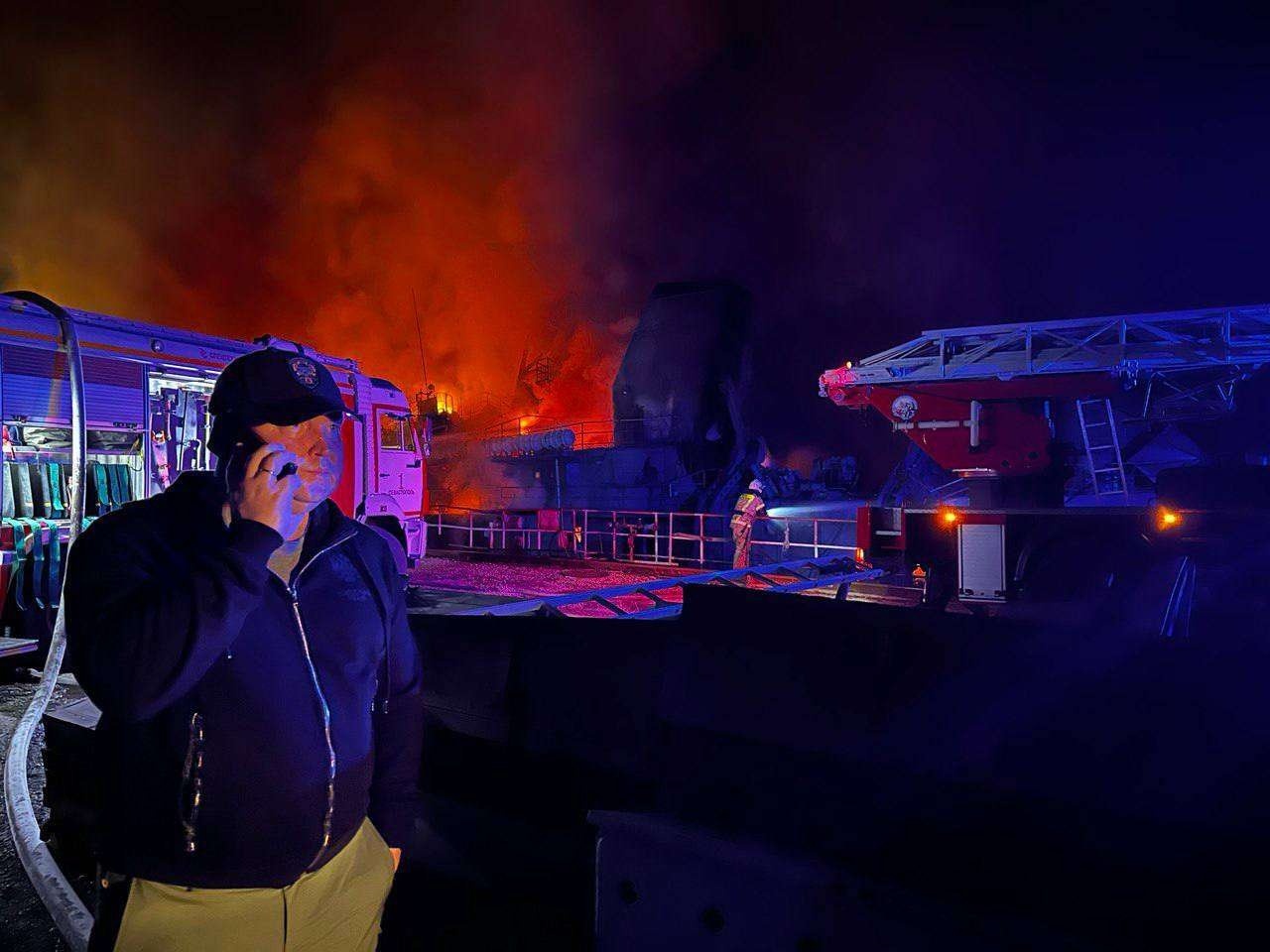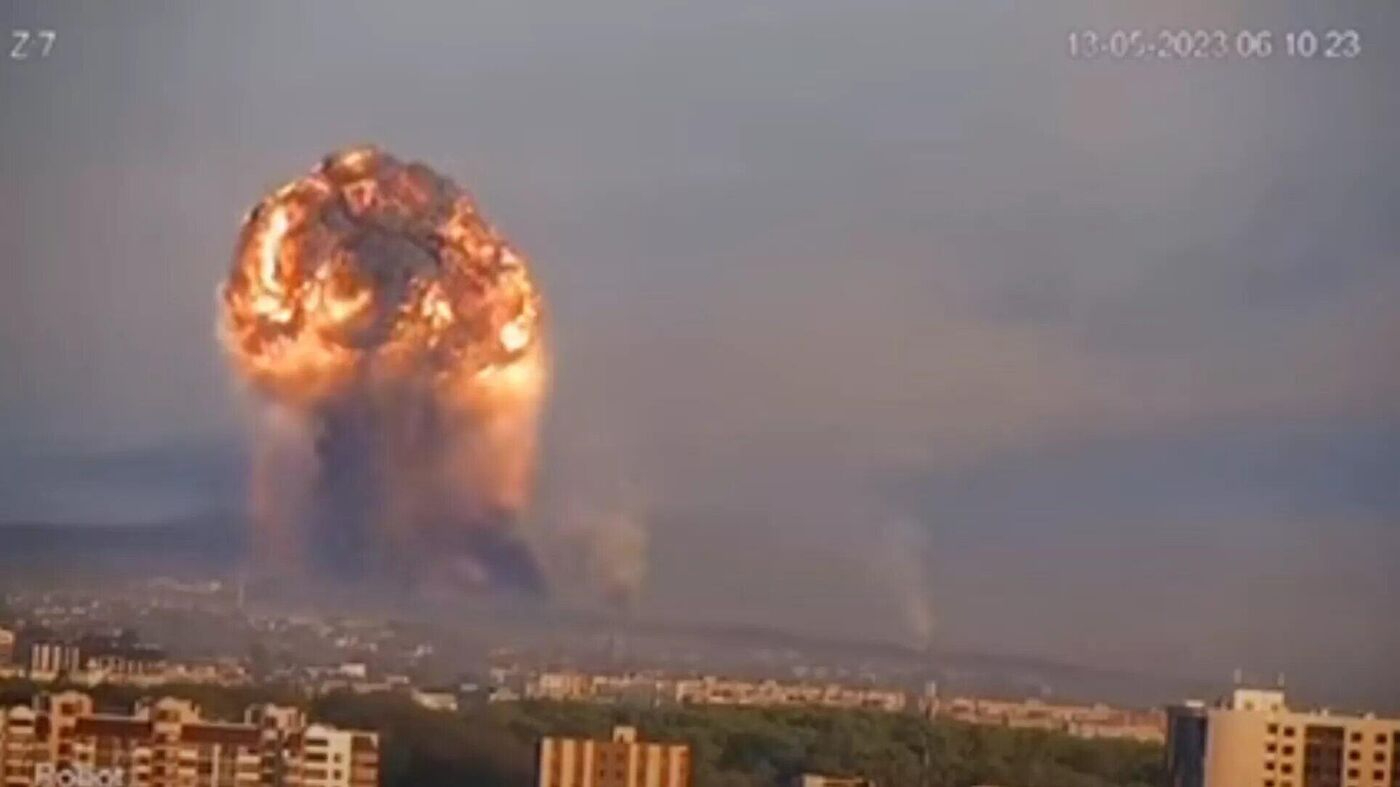In an unusual publicity material, the Russian Ministry of Defense (RuMoD) on Thursday released follow-up footage of a cruise missile strike it conducted on a large Ukrainian ammunition depot in Kherson, showing the aftermath of the destruction.
The strike seems to be in retaliation to the devastating Ukrainian missile attack on the Black Sea Fleet headquarters last week in Crimea’s Sevastopol, which damaged a landing craft and a submarine.
The hit comes amid a turning point in the war, an unprecedented escalation in the Black Sea and some credible breaches to Russia’s admittedly impenetrable defensive lines.
It suggests a Russian strategy where it will continue to bomb the weapons dumps containing the West’s donations to Ukraine.
However, it also tests Russia’s defensive posture, where Ukraine and the US seem prepared for a long war. By continuing to arm Ukraine, they match Russia’s approach of undertaking long, attritional campaigns until the military and political goals are achieved.
Experts have long wondered when Russia would launch its counteroffensive and take the remaining bit of the separatist pro-Russian regions in the south and the west.
Russia Always Blamed NATO & West
Military bloggers have long called for Russia to shed restraint and shoot down US and NATO aircraft like the E-3 AWACS, the RQ-4 Global Hawk, and the RC-135 Rivet that get airborne 24/7 from NATO territory. These provide Ukraine with targeting data and technical intelligence on Russian radars.
This helps Ukraine conduct drone strikes inside Moscow and Belgorod and the sea kamikaze drone attacks on the Russian navy in the Black Sea. The latest Storm Shadow strike on the fleet headquarters ideally should warrant such action since US and NATO military and technical support to Ukraine has crossed Russian red lines multiple times.

Despite NATO’s gradual escalation, Moscow stopped accusing it of assisting these Ukrainian strikes and rear-end technical and manpower support. But it never threatened to shoot down these particular mission aircraft, like it announced no capture or formal PoW treatment to the many foreign mercenaries fighting in Ukraine.
The downing of the MQ-9 Reaper only saw US drone activity over the Black Sea being suspended briefly before resuming to previous levels. The reasons behind Russia not undertaking a counteroffensive now and escalating the war — that has presumably injected a feeling in Washington that Moscow’s desire to prevent a direct fight with NATO outweighs the painful US/NATO-backed strikes — can be said to be owing to a dilemma.
Hitting NATO aircraft and going on the offensive against Ukraine now might expend its ammunition and reveal its military playbook before an eventual clash it is expecting with NATO in the future. But staying defensive also allows Ukraine and NATO to continue to breach its red lines.
RuMoD Videos
In a release on September 25, the RuMoD featured footage from an overhead drone and ground observation posts, showing massive explosions from various angles in thermal and regular vision modes, destroying “12 hangars and 3,000 tons of arms and ammunition” at a depot near Kiselevka, near Kherson. The explosions were a result of “air-launched cruise missile strikes.”
A subsequent video on September 27 from a drone showed the aftermath of that strike as “objective control data of AFU joint arms and ammunition depot by air-launched cruise missile.” Flattened debris could be seen still billowing smoke.
Russia’s Dilemma
Along with the Black Sea strikes, if Ukraine’s small, incremental gains along Russia’s defensive lines — as a part of a new, more suitable ‘non-Western’ ground warfare strategy is considered — should technically justify a counteroffensive. But it appears to remain defensive. And both approaches are equally fraught with risks.

“It has to go on a counteroffensive at some point. But it could not escalate earlier since it wanted to avoid a war with NATO and play right into NATO’s provocation. But today, when we see Ukraine positioned to threaten Russia’s impenetrable defensive lines and NATO and Kyiv lighting up Crimea and the Black Sea, it cannot escalate even more since it does not have the weapons numbers. Its production capacity will face hiccups at some point,” said defense analyst Sandeep Mukherjee.
Russia’s dilemma is to remain in a permanently active defensive posture, which gives NATO and Ukraine opportunities to breach its red lines.
But attacking risks expending itself before that anticipated clash with the US and NATO. However, Moscow seems to have catered to this situation too. This is where the broader geopolitics regarding the closing of ranks between Russia, Iran, China, and North Korea comes into play.
Drone, Ammunition Supply From Iran And North Korea & Strategic Support From China
Russia giving a defense-industrial heft to its relations with North Korea and Iran, which envisages acquiring mass-manufactured drones, missiles, and artillery shells while sharing advanced weapons technology with the two, can be seen as a step in this direction.
Eurasian Times has analyzed the Russia-Iran-North Korea military technological axis here and here. Moreover, Tehran and Pyongyang are also politically/ideologically invested in this arrangement since they face the same strategic confrontation from the US.
“Russia’s war with NATO might not be limited to Europe and also include far east and northeastern Asia,” Mukherjee added. China comes into the picture here, as earlier articles showed how increasing engagement between NATO and Japan over the last decade and enhancing NATO-Taiwan contact has led Beijing to perceive the same security threat from the trans-Atlantic alliance.
This also disproves occasional claims about China secretly disapproving of Russia’s war in Ukraine. It had been said that the conflict was growing too much to bear, testing its silence over its ally’s actions. China’s leadership remaining neutral over the war and abstaining from votes in UN resolutions was never a measure of its secret opposition to Moscow but rather a way of not jeopardizing its deep trade ties and Belt and Road Initiative (BRI) projects in Europe.
That it fully understood and empathized with Russia’s reasons to go to war is reflected in its Ministry of Foreign Affairs (MFA) statements since the start of the war in February 2022. Spokespersons Hua Chunying, Zhao Lijian, and Wang Wenbing have consistently criticized “reckless NATO expansion” and slammed the US and NATO for “provoking bloc confrontation” and promoting a “Cold War mentality” for precipitating the conflict.
If Russia Loses, China & North Korea Are Not Far Behind
If anything, Beijing and Pyongyang are most invested in Russia’s victory, as a NATO triumph in Europe will set off a ripple effect in the western Pacific, right outside their shores. Sino-Russian strategic air and naval exercises in the Sea of Japan and near the Arctic since the last two years, with tellingly coordinated North Korean missile drills, are meant to pressure the US Navy into stretching its assets. This takes the pressure off either of them without directly having to rush to their ally’s aid.
In other words, the US Navy and US Air Force will have to keep substantial assets for counter exercises and trailing Russo-Chinese naval drills, preventing them from fully rushing to Taiwan’s aid, sailing the Sixth Fleet into the Baltic Sea, or moving an aircraft carrier group into the Black Sea to liberate Crimea. Analysts often miss that Europe is very much a part of the US’s Indo-Pacific strategy, which Moscow and Beijing firmly conclude is a “dual-containment” ploy.
Any Russian inability to hold off the strikes on Crimea or the beginning of the reversal of its gains in Ukraine will see extremely well-coordinated Chinese semi-strategic maneuvers and diplomatic moves to raise pressure on NATO and the US. China and Russia are joined at the hip, and the first real signs of a threat to Russian achievements in Ukraine will see the tacit understandings between them to back the other unfold — even without a formal military alliance.
- The author can be reached at satamp@gmail.com
- Follow EurAsian Times on Google News




